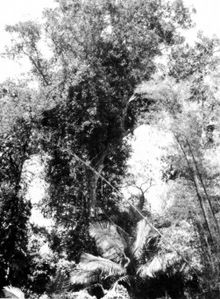
The geography of Puerto Rico consists of an archipelago located between the Caribbean Sea and the North Atlantic Ocean, east of the Dominican Republic or Hispaniola, west of the Virgin Islands and north of Venezuela. The main island of Puerto Rico is the smallest and most eastern of the Greater Antilles. With an area of 3,515 square miles (9,104 km2), it is the third largest island in the United States and the 82nd largest island in the world. Various smaller islands and cays, including Vieques, Culebra, Mona, Desecheo, and Caja de Muertos comprise the remainder of the archipelago with only Culebra and Vieques being inhabited year-round. Mona is uninhabited through large parts of the year except for employees of the Puerto Rico Department of Natural Resources.

El Yunque National Forest, formerly known as the Caribbean National Forest, is a forest located in northeastern Puerto Rico. It is the only tropical rainforest in the United States National Forest System and the United States Forest Service. El Yunque National Rainforest is located on the slopes of the Sierra de Luquillo mountains, encompassing more than 28,000 acres of land, making it the largest block of public land in Puerto Rico.

The Burseraceae are a moderate-sized family of 17-19 genera and about 540 species of flowering plants. The actual numbers differ according to the time period in which a given source is written describing this family. The Burseraceae are also known as the torchwood family, the frankincense and myrrh family, or simply the incense tree family. The family includes both trees and shrubs, and is native to tropical regions of Africa, Asia. Australasia, and the Americas.

Cordillera Central, is the main mountain range in Puerto Rico. The range crosses the island from west to east and divides it into its northern and southern coastal plains. The Cordillera Central runs eastward from the municipality of Maricao in the west to Aibonito in the central eastern region, and on to the Caribbean in the southeast through the Sierra de Cayey. The Central Mountain Range consists of the Cordillera Central proper and numerous subranges, foothills and ridges that extend throughout the island. Cerro de Punta is both the highest peak of the Cordillera Central and the highest point in Puerto Rico. The Sierra de Luquillo, where El Yunque is located, is sometimes included as a subrange or eastward extension of the Cordillera Central.

The elfin woods warbler is a species of bird endemic to Puerto Rico, where it is local and uncommon. Discovered in 1968 and described in 1972, it is the most recently described New World warbler.

El Toro Wilderness is a 10,254-acre (41.5 km2) federally designated National Wilderness Preservation System unit located within El Yunque National Forest on the Sierra de Luquillo in eastern Puerto Rico. El Toro, named after the highest peak in the forest at 3,524 feet (1,074 m), is the only tropical wilderness in the United States National Forest System. It was created in 2005 by the Caribbean National Forest Act of 2005.

Toro Negro State Forest is one of the 21 forests that make up the public forests system in Puerto Rico. It is also Puerto Rico's highest cloud forest. It is in the Cordillera Central region of the island and covers 8,204 cuerdas, of mountains. Toro Negro's mountains have heights reaching up to 4,400 feet (1,300 m) and include Cerro de Punta, Cerro Jayuya and Cerro Rosa, the three highest peaks in the island. Nested among these mountains is Lake Guineo, the island's highest lake. The forest has 18 kilometers (11 mi) of trails, an observation tower, two natural swimming pools (Spanish:"charcos"), camping and picnic areas, nine rivers, and numerous creeks and waterfalls. The forest spans areas within the municipalities of Ponce, Jayuya, Orocovis, Ciales, and Juana Díaz, and consists of seven non-contiguous tracts of land. The largest contiguous segment of the forest is located in the municipalities of Ponce and Jayuya. Some 40% of the area of Toro Negro State Forest is located in Ponce's Barrio Anón.
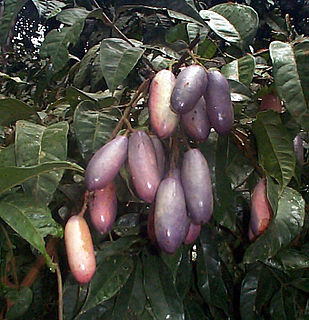
Dacryodes is a genus of about 60 species of trees in the family Burseraceae. The generic name is from the Greek dakruon meaning "tear(drop)", referring to how resin droplets form on the bark surface.
Amauropelta inabonensis, synonym Thelypteris inabonensis, is a rare species of fern known by the common name cordillera maiden fern. It is endemic to Puerto Rico, where it is known from only two localities: at the headwaters of Río Inabón and at the Toro Negro State Forest. It is a federally listed endangered species of the United States.
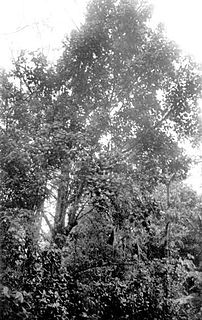
Magnolia portoricensis is a tree of the Caribbean region. Its vernacular names include jagüilla and Puerto Rico magnolia. It is native to Puerto Rico and it is found in the Toro Negro State Forest. It is an endangered tree and endemic to Puerto Rico. It is a dicot and a part of the family Magnoliaceae. It is an uncommon tree, found primarily in the central and western mountains at 500 to 925 m above sea level.
Buchenavia capitata is a tree of the Caribbean and northeastern South-American regions. Its Spanish vernacular names include granadillo, almendro (Colombia), amarillo and olivo negro (Venezuela), and mirindiba and periquiteira (Brazil). Its English vernacular name is fourleaf buchenavia. It is also known as Buchenavia tetraphylla (Aubl.) Howard.
Vitex divaricata is a tree shrub of the Caribbean native to Puerto Rico and the US Virgin Islands. Its Spanish vernacular names include higüerillo and higuerillo. Its English vernacular name is white fiddlewood. It belongs to the order Lamiales. This tree is common in the Toro Negro State Forest.
Prunus occidentalis is a plant in the family Rosaceae of the order Rosales.

Cyathea arborea is a plant of the family Cyatheaceae in the order Cyatheales. Tree ferns are an ancient form of plant life that still survive in tropical forests. This species of tree fern is native to the Caribbean, including Cuba, Hispaniola, and the El Yunque National Forest in Puerto Rico.
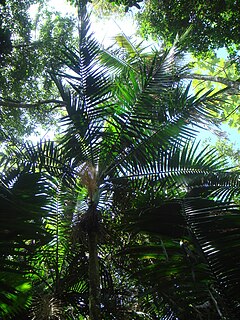
Prestoea montana is a perennial palm in the family Arecaceae. It is considered a synonym of Prestoea acuminata var. montana.

Pouteria multiflora is a plant in the family Sapotaceae of the order Ericales. Its English common name is bullytree. Its Spanish common names include jácana, ácana, acana, hacana, or jacana. It is native to North and South America. The plant is common in the Toro Negro State Forest.

The Puerto Rican broad-winged hawk is an endangered subspecies of the broad-winged hawk. It is a small hawk that occurs in Puerto Rico, inhabiting the Toro Negro State Forest. Its Spanish common name is guaragüao de bosque.
Macrobrachium crenulatum is an amphidromous freshwater shrimp of the Palaemonidae family in the Decapoda order. It is found in lowland rivers and streams from Panama to Venezuela, as well as on several Caribbean islands. The species is common in the Toro Negro State Forest in central Puerto Rico. Studies have shown that the species have higher sensitivity to environmental, hydrological and chemical factors than other crustaceans also studied and which affect its migratory patterns.

The Luquillo Experimental Forest is a protected area of tropical rainforest in northeastern Puerto Rico. The experimental forest is located in the Sierra de Luquillo some 50 km (30 mi) east of San Juan, the capital of the island. It is a UNESCO Biosphere Reserve and is used for research into silviculture, forest regeneration, and other purposes.
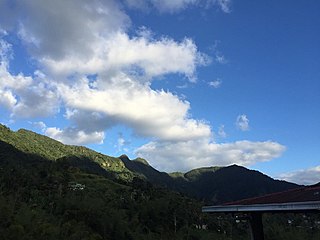
Los Tres Picachos State Forest is one of the 20 forests that make up the public forest system of Puerto Rico. The forest is located in the Central Mountain Range or Cordillera Central, along the Los Tres Picachos mountain ridge, one of the island's highest mountains, named after the distinctive three peaks of the highest mountain in the forest. The state forest is located in the municipalities of Jayuya and Ciales.
